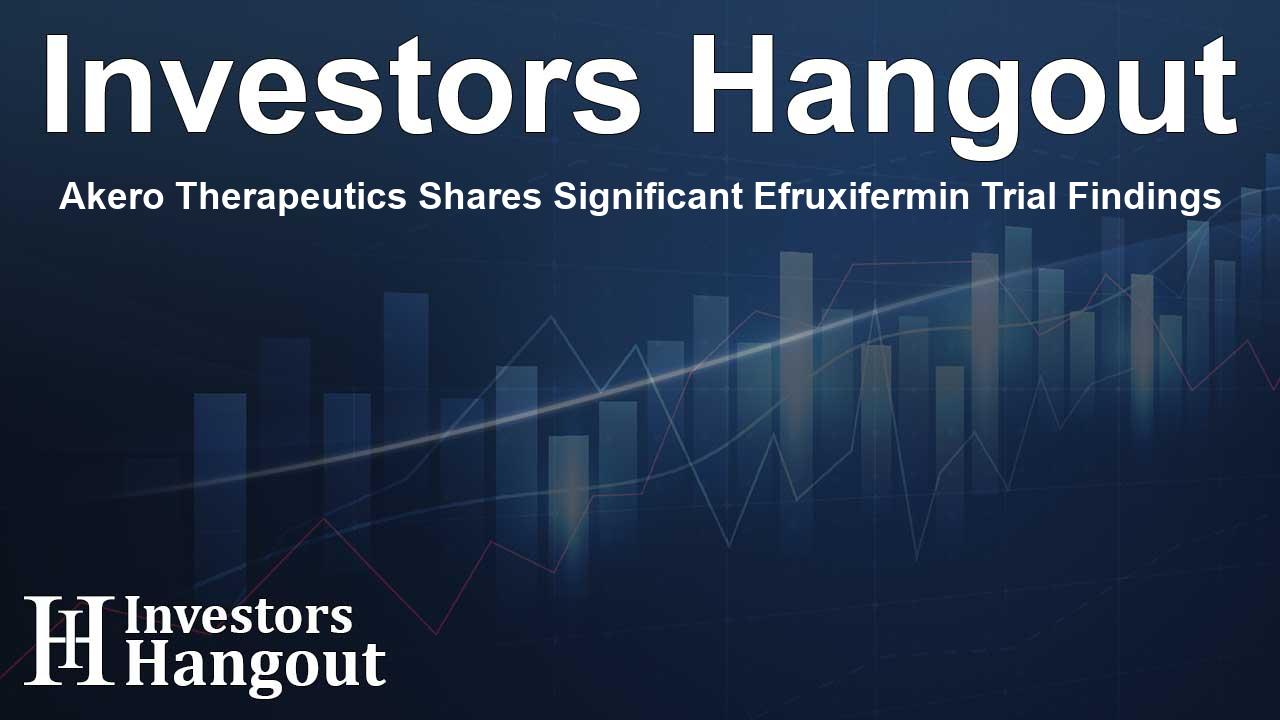Akero Therapeutics Shares Significant Efruxifermin Trial Findings

Akero Therapeutics Highlights Efruxifermin's Impact on Fibrosis
In an exciting development for patients battling serious metabolic diseases, Akero Therapeutics, Inc. (NASDAQ: AKRO) has shared promising results from the Phase 2b SYMMETRY trial, which investigates the effectiveness of efruxifermin (EFX) for treating compensated cirrhosis caused by metabolic dysfunction-associated steatohepatitis (MASH). Presenting at the European Association for the Study of the Liver (EASL) Congress, the findings suggest that EFX could be a game-changer for those suffering from this challenging condition.
Significant Findings from the SYMMETRY Trial
Kitty Yale, Chief Development Officer at Akero, remarked that the data revealed by the SYMMETRY trial differentiates EFX from current MASH treatments. The study's outcomes highlight a significant improvement in fibrosis among patients after 96 weeks of treatment. This is particularly noteworthy as patients with compensated cirrhosis typically have limited options and face a dire prognosis without liver transplantation.
Understanding the Clinical Trial's Design
The SYMMETRY study was a multicenter, randomized, double-blind, placebo-controlled Phase 2b trial that included participants with biopsy-confirmed compensated cirrhosis due to MASH. A total of 182 patients were randomized, and those receiving EFX experienced notable benefits throughout the trial duration. At week 96, the data showed that 39% of those taking EFX 50mg exhibited signs of fibrosis improvement without worsening their MASH, compared to just 15% in the placebo group.
Evaluating EFX's Efficacy
The trial was particularly designed to assess changes in fibrosis through both completer and intention-to-treat (ITT) analyses. The findings demonstrated that 29% of the EFX 50mg group in the ITT analysis attained improvements, notably outpacing the 11% observed in the placebo group. These results affirm efruxifermin's promise as a therapeutic agent capable of not only improving fibrosis but doing so without exacerbating MASH symptoms.
Key Statistics from the Week 96 Analysis
The analysis highlighted a significant increase in the efficacy of EFX over the duration of the trial. Specifically, the EFX 50mg group showed more than double the placebo-adjusted treatment effect from Week 36 to Week 96, reflecting a substantial enhancement of results over time. This suggests that prolonged treatment with EFX is beneficial for patients suffering from compensated cirrhosis.
Promising Non-Invasive Measures
In addition to the biopsy results, non-invasive measurements such as liver stiffness and the ELF test score indicated continued improvement in liver health for patients receiving EFX. The data underlines the compound's ability to effectively support liver function, an encouraging sign for treating MASH-related conditions.
Safety Profile and Tolerability of Efruxifermin
The safety profile of EFX aligns with previous studies, indicating that the most common adverse events reported were mild to moderate gastrointestinal issues, such as diarrhea and nausea. Importantly, serious adverse effects related to the drug were not observed, reaffirming EFX's tolerability.
Implications for Future Treatment Options
The potential for EFX to improve fibrosis across various patient subgroups, regardless of diabetes status or concurrent medications, offers considerable hope in addressing the unmet needs related to MASH. Akero plans to continue its Phase 3 SYNCHRONY program, which is aimed at further evaluating EFX’s efficacy across MASH stages.
About Akero Therapeutics
Akero Therapeutics is at the forefront of innovation in developing transformative therapies for metabolic diseases. With its primary candidate, efruxifermin, the company is on a mission to improve patient outcomes for those affected by MASH and other metabolic dysfunctions. With the ongoing SYNCHRONY program and the promising results from SYMMETRY, Akero is strengthening its position in the clinical landscape.
Frequently Asked Questions
What is efruxifermin?
Efruxifermin (EFX) is Akero Therapeutics' lead product candidate designed for treating compensated cirrhosis due to MASH, showcasing significant efficacy in clinical trials.
What does the SYMMETRY trial aim to achieve?
The SYMMETRY trial aims to evaluate the efficacy and safety of EFX in improving fibrosis without exacerbating MASH in patients over a 96-week period.
How does efruxifermin work?
EFX is engineered to mimic native growth factor activity, which helps reduce fibrosis and improve liver function in patients with MASH.
What are the primary outcomes of the SYMMETRY study?
The critical outcomes include the percentage of patients achieving fibrosis improvement without worsening their MASH symptoms over the 96-week period.
What are the next steps for Akero Therapeutics?
Akero will continue to advance its ongoing Phase 3 SYNCHRONY studies to further explore EFX's clinical benefits across a range of MASH-related conditions.
About The Author
Contact Riley Hayes privately here. Or send an email with ATTN: Riley Hayes as the subject to contact@investorshangout.com.
About Investors Hangout
Investors Hangout is a leading online stock forum for financial discussion and learning, offering a wide range of free tools and resources. It draws in traders of all levels, who exchange market knowledge, investigate trading tactics, and keep an eye on industry developments in real time. Featuring financial articles, stock message boards, quotes, charts, company profiles, and live news updates. Through cooperative learning and a wealth of informational resources, it helps users from novices creating their first portfolios to experts honing their techniques. Join Investors Hangout today: https://investorshangout.com/
The content of this article is based on factual, publicly available information and does not represent legal, financial, or investment advice. Investors Hangout does not offer financial advice, and the author is not a licensed financial advisor. Consult a qualified advisor before making any financial or investment decisions based on this article. This article should not be considered advice to purchase, sell, or hold any securities or other investments. If any of the material provided here is inaccurate, please contact us for corrections.
